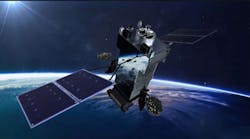Lockheed Martin moves forward with developing next-generation geosynchronous satellites for missile defense
Questions and answers:
- What is the Next-Gen OPIR program? It is a U.S. missile warning satellite system to detect and track ballistic, hypersonic, and emerging missile threats; it will replace the current SBIRS system.
- What company is responsible for developing satellites for the program? Lockheed Martin is developing the geosynchronous Earth orbit (GEO) satellites, with payloads provided by RTX Raytheon, while Northrop Grumman is developing polar-orbiting satellites.
- When will the first GEO and polar-orbiting satellites be launched? The first GEO satellites are to launch in 2025 or 2026, while the polar-orbiting satellites are planned for launch around 2028.
LOS ANGELES AFB, Calif. – Satellite reconnaissance experts at Lockheed Martin Corp. are moving forward with developing geosynchronous Earth orbit satellites for the U.S. Space Force Next-Generation Overhead Persistent Infrared (Next-Gen OPIR) program.
Officials of the Space Force Systems Command at Los Angeles Air Force Base, Calif., announced an $87.1 million order to the Lockheed Martin Space segment in Sunnyvale Calif., for the Next-Gen OPIR geosynchronous segment.
The Next-Gen OPIR program is a U.S. missile warning satellite system intended to replace the current Space-Based Infrared System (SBIRS). It consists of satellites in geosynchronous Earth orbit (GEO) and elliptical polar orbits, equipped with advanced infrared sensors to detect and track ballistic missile launches, hypersonic, and other emerging missile threats.
It is to provide early warning and missile defense for the U.S. and its allies. Managing the GEO component is Lockheed Martin with payloads from RTX Raytheon. GEO provides persistent coverage over mid-latitudes globally from about 22,000 miles above the Earth's surface.
Polar-orbiting satellites
Managing the polar-orbiting satellites are Northrop Grumman Corp. and Ball Aerospace. These satellites cover the northern polar region where missile threats often travel the shortest routes.
The system offers detection sensitivity for fast-burning or dim missile boosters and is designed to operate in contested and congested space. Sensors and communications provide missile warning, tracking, and integration with other missile-defense satellites. The first GEO satellites should launch this year or next,, and polar satellites should launch around 2028.
This order to Lockheed Martin brings the value of the contract is to $8.1 billion. On this order Lockheed Martin will do the work in Longmont, Colo., and Sunnyvale, Calif., and should be finished by July 2029. For more information contact Lockheed Martin Space online at https://www.lockheedmartin.com/en-us/who-we-are/business-areas/space.html.
About the Author
John Keller
Editor-in-Chief
John Keller is the Editor-in-Chief, Military & Aerospace Electronics Magazine--provides extensive coverage and analysis of enabling electronics and optoelectronic technologies in military, space and commercial aviation applications. John has been a member of the Military & Aerospace Electronics staff since 1989 and chief editor since 1995.
